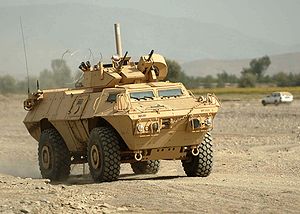M1117
| M1117 Armored Security Vehicle | |
|---|---|

A U.S. Army M1117 Armored Security Vehicle in Khost Province, Afghanistan in September 2007
|
|
| Type | Internal security vehicle |
| Place of origin | United States of America |
| Service history | |
| In service | 1999–present |
| Used by | See Operators |
| Wars |
War in Afghanistan Iraq War Iraqi insurgency (2011–present) Colombian Conflict |
| Production history | |
| Manufacturer | Textron Marine & Land Systems |
| Specifications | |
| Weight | 29,560 lb (13,410 kg) |
| Length | 237 inches (6.0 m) |
| Width | 101 inches (2.6 m) |
| Height | 102 inches (2.6 m) |
| Crew | 3/1 passenger |
|
|
|
| Armor | IBD Modular Expandable Armor System |
|
Main
armament |
40 mm Mk 19 grenade launcher, .50 caliber M2HB |
|
Secondary
armament |
M240H Medium Machine Gun |
| Engine | Cummins 6CTA8.3 260 hp, 828 foot-pounds |
| Suspension | 4×4 wheeled, fully independent |
|
Operational
range |
440 miles at 40 mph |
| Speed | 63 mph (101 km/h) |
The M1117 Guardian, also denoted as the Armored Security Vehicle (ASV), is an internal security vehicle based on the V-100 and V-150 Commando series of armored cars. It was developed in the late 1990s for service with the United States Military Police Corps. The first prototypes appeared in February 1997 and serial production of the M1117 commenced between 1999 and early 2000.
The M1117 was one of the first American military vehicles to be built on a specialized mine-resistant hull, and after 2001 was adopted in increasing numbers as a direct response to the threat posed by improvised explosive devices to US forces in Iraq and Afghanistan. Its armament consists of an Mk 19 grenade launcher and M2HB Browning machine gun, mounted in a turret similar to that used on the U.S. Marine Corps' Amphibious Assault Vehicle; and a M240H Medium Machine Gun mounted outside the gunner's hatch. The vehicle was utilized by American military police and convoy security units in Iraq and Afghanistan. It is a more heavily protected and heavily armed alternative to the armored Humvee which was not originally designed to be a protected fighting vehicle. In 2015 Textron Systems rebranded the M1117 as the COMMANDO™ family of vehicles, bringing back the name of the vehicle from which the M1117 was derived.
In the 1980s, American military doctrine emphasized two distinct types of equipment. Tanks and infantry fighting vehicles were for frontline combat, and unarmored utility vehicles for transport behind the lines. In 1993, the military had to fight through Mogadishu in unarmored Humvees, leading to the development of up-armored models. Many generals doubted the benefits, but the Military Police Corps, tasked with patrolling the "safe" rear area behind the battle line insisted that the Army fund a slow but steady production of the bullet resistant M1114 Humvee.
...
Wikipedia
